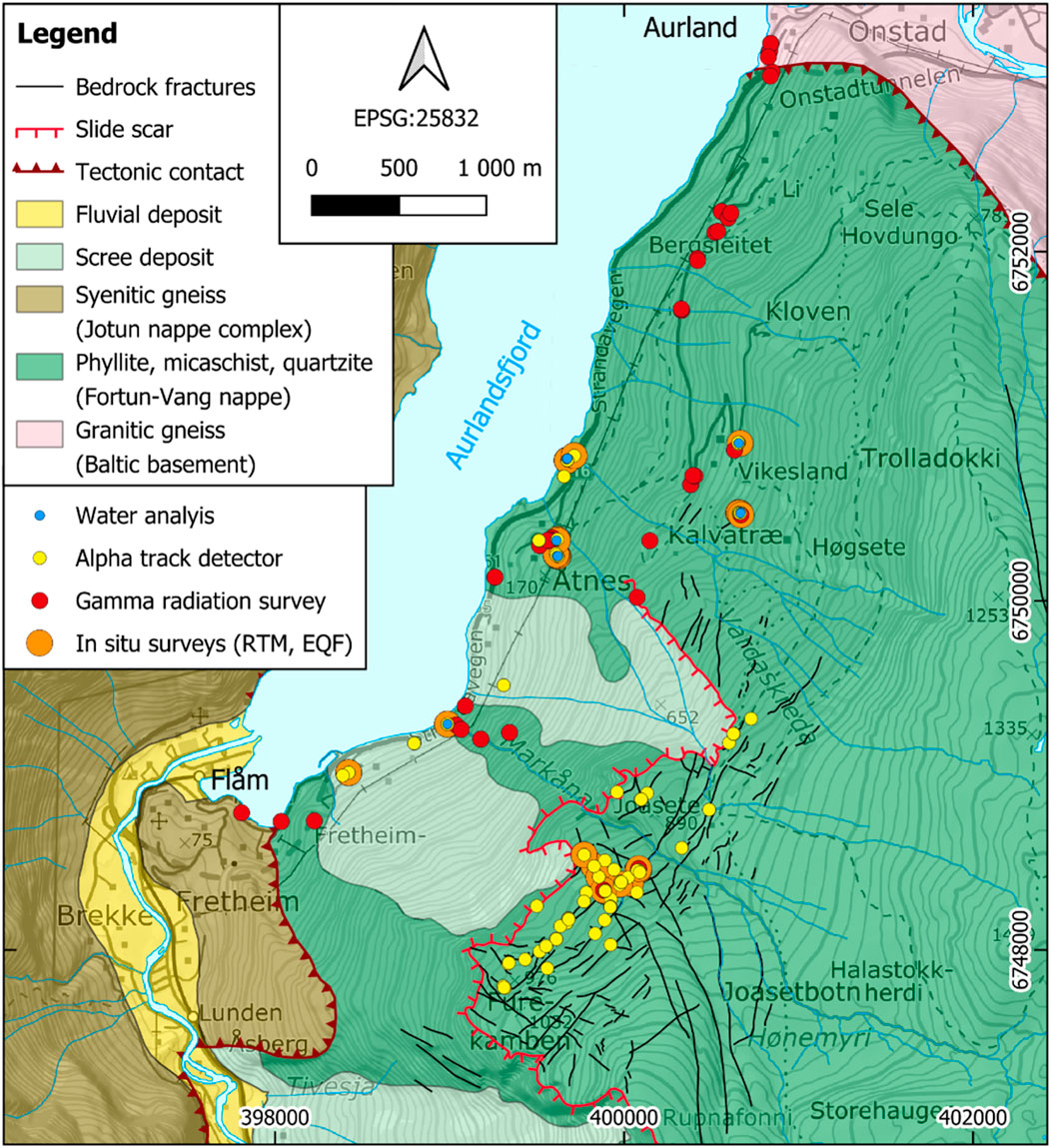- 1Norwegian Radiation and Nuclear Safety Authority, Østerås, Norway
- 2Department of Civil Engineering and Environmental Sciences, Western Norway University of Applied Sciences, Sogndal, Norway
Open fractures lead to increased permeability of the bedrock, and, if connected to the surface, allow for groundwater flow and air ventilation. Radon and thoron received by groundwater and ventilating air from bedrock can then be released at the surface. We assessed outdoor levels of radon, thoron and their progeny within the area of Stampa, a rock slope instability in western Norway, characterised by open bedrock fractures and subsurface fracture networks. We used alpha track detectors and in-situ measurements, finding outdoor radon levels of up to 2500 Bq m-3 compared to the global averages of 10 Bq m-3. These outdoor measurements had medians of 70 and 92 Bq m-3 and means of 230 and 280 Bq m-3, which is higher than the maximum recommended indoor radon level of 200 Bq m-3 in Norway. We identified natural ventilation through open fractures as one important source of these enhanced outdoor levels, and another to be transport by groundwater and release at natural groundwater springs. Natural chimney ventilation changes flow direction between warm and cold seasons, and we identified different levels of radon and thoron between different types of fractures suggesting different ventilation intensities and possibly different sizes of subsurface fracture networks.
Introduction
Radon, thoron and their progeny are important contributors to the dose received by the public (UNSCEAR, 2006). The health risk is well documented for uranium mine workers (BEIR-VI, 1999) and for the public regarding indoor radon (Darby et al., 2006), which is often increased due to pressure reduction from heating/ventilation and flux of soil gas with radon from the ground.
Outdoor levels of radon and thoron are often low, with global averages around 10 Bq m-3 (UNSCEAR, 2006), and any associated risk is only rarely considered (e.g., Petermann and Hoffmann, 2025). Normally, outdoor levels of radon result from soil exhalation that is heavily diluted in the atmosphere. However, levels of radon in soil gas can be enhanced at or near faults and fractures (Neri et al., 2011; Johnová et al., 2014; Yakut et al., 2017) and increased outdoor levels have been suggested to be affected by seismic activity (Zhao et al., 2024; Monnin and Seidel, 1997). It has previously been shown that levels in underground cavities are often enhanced (Çevik et al., 2012; Haanes and Rudjord, 2018; Haanes et al., 2023; Solomon et al., 1992). The local impact of chimney ventilation of underground spaces on outdoor levels of radon, thoron and their progeny has however been rarely addressed. Haanes and Rudjord (2018) showed that natural ventilation through underground cavities with high levels of radon and thoron results in high local outdoor levels. It has been suggested that natural ventilation of bedrock fractures may involve significant exhalation of radon, that may result in high local levels (Ayo-Bali and Ajayi, 2024; Wang et al., 2019; O'Connor et al., 1992). In areas with open fractures, levels of ventilating air and its related outdoor risk from radon and thoron may be non-negligible and should therefore be assessed.
We have assessed outdoor radon levels within the area of the unstable rock slope Stampa in western Norway (Figure 1), where mostly the upper part is characterised by fracture networks, whereas the lower parts are covered by scree deposits originating from rock avalanches (Henriksen and Dale, 2018; Böhme et al., 2013; Corfu, 2023). Along the foot of the slope, several groundwater springs can be found (Henriksen and Dale, 2018). The height of the area spans from sea level to around 900 m of the mountainside (ca. 25-degree slope), for about 3.5 km northeast-southwest and 2 km southeast-northwest (slope direction), where fractures trend both perpendicular and parallel to the slope (cf. Henriksen and Dale, 2018). The bedrock geology in the area is characterized by three main tectonic units, which are from bottom to top: 1) the Baltic basement consisting of mainly granitic gneiss, 2) the metasedimentary Fortun-Vang nappe which consists predominantly of phyllite-containing subordinate graphite and quartzite layers, and 3) the Jotun-Valdres nappe complex consisting of various deformed magmatic rocks. The Fortun-Vang nappe and the Jotun-Valdres nappe complex were emplaced onto the Baltic basement during the Caledonian orogeny (Corfu, 2023). The Stampa rock-slope instability is situated within phyllitic rocks of the Fortun-Vang nappe. Phyllite can be enriched with uranium (Lindahl, 1983), and significant build-up of radon in soil gas and in air and water within bedrock fractures may be anticipated. In the study area, there is an increased risk related to radon levels, which has been quantified as 5%–20% and even more than 20% of houses having indoor radon levels of more than 200 Bq m-3 (Jerstad et al., 2003). Large parts of the study area are unpopulated except for some hiking trails and cabins. The houses that are included within this study are all situated close to sea-level in the lower part of the study area. In addition to outdoor levels, we assessed radon and thoron levels within fracture openings at Stampa, as well as levels of progenitors in bedrock. This was done to assess: 1) whether and when open fractures have a measurable enhanced natural exhalation of radon and thoron, 2) whether such ventilation may impact local outdoor levels, and, 3) whether this may be associated with bedrock levels of progenitors.
Methods
Alpha track detectors
We used alpha track detectors to measure fracture and outdoor levels. In total 58 pairs of detectors attained integrated measurements of radon and thoron and 34 single radon detectors gave additional results (Radtrack2 CR-39, the only applied type of alpha track detector). These measurements were done during six different campaigns, which lasted from Aug-October 2020 (57–58 days), Nov-January 2020 (75 days), Mar-April 2021 (21 days), Mar-April 2022 (25 days), Jul-August 2023 (25 & 55-57days) and Aug-October 2023 (43 & 53 days). Outdoor measurements were only performed in the warm season with detectors hanging from trees at 1.5–2 m above ground. Detectors were protected by a small covering made of the top of a plastic bottle. Potentially ventilating fractures were also assessed in early spring and winter with detectors hanging from tree branches or planks inserted to approximately the middle of the fracture opening in order to avoid proximity to the fracture wall. Many outdoor localities had several alpha track detectors but were only assessed once (one campaign per locality). Most fractures were only measured with alpha track detectors once and only one set of detectors, except 7 fractures that were assessed two or three times and 6 fractures in 2023 that had double sets of detectors and the cave which had detectors at several places. For each alpha track detector pair, one detector is closed so that only the longer-lived radon can enter while the other detector has open holes that allow both radon and thoron to enter, and by subtracting the radon, one can estimate thoron activity concentration. Detectors were provided and analysed by Radonova AB. We present detector results for 92 radon measurements (35 outdoors, 57 in fractures) and 58 thoron measurements (34 outdoors, 24 in fractures). Measurement uncertainties (k = 1) among the alpha track detectors were for radon from 5 to 1500 Bq m-3 and for thoron from 21 to 123 Bq m-3 but were for both very strongly correlated to the value of the measurement (r > 0.98, p > 0.003). Due to the shorter periods of exposure, compared to the 2-month period required for standardised indoor measurements, detection limits (40–6000 Bq m-3) were for many thoron measurements higher than the calculated activity concentration. For these we use the calculated activity concentration (based on alpha track counts). For radon, detection limits were 20–50 Bq m-3 (five cases only). One long-term alpha track detector measurement in a fracture during year 2020 had too many tracks and the measurement was >5200 Bq m-3 but to include as much data as possible, and achieve a conservative approach, we used this value (rather than the real higher level). Also, one alpha track radon detector was lost in 2022, and the thoron counterpart was analysed and erroneously reported, together with radon measurement at another location. However, since radon comprise the difference, we assumed little thoron present and used the difference as a proxy for radon at this location.
We differentiate and assess whether there are differences in radon and thoron between single open fractures versus open fracture networks. A very large fracture cavity was treated separately and termed “cave”. To assess the impact of potentially ventilating fractures on outdoors levels, we identified areas of 60-m diameters of potential impact from fractures on outdoors measurements (summer campaign 2023). We used the mean among either fracture or outdoor alpha track detector measurements of radon and thoron in each such area, respectively (7 areas for radon, n = 20, and 6 areas for thoron, n = 19), and assessed them through Pearson correlation.
In situ radon, thoron and progeny measurements in air
To attain point measurements of outdoor localities and to assess ventilation in more fractures and address temporal variation in these, in-situ instruments were used during two field campaigns (autumn 2021 and summer 2023). Three instruments, a SARAD© RTM1688 (radon and thoron) and two SARAD© EQF 3220 were used. Outdoor measurements were performed at 1.5 m height with the instrument on a tripod while measurements in vent openings were performed with the instrument on the ground (as there was no space for a tripod) approximately in the center of the fracture opening and air entering the instrument was then taken at approximately 20 cm height at the top of the instrument (radon and thoron), while progeny were sampled at an additional height of 15 cm where the external alpha probe is situated above the instrument (EQF). All three were calibrated at SARAD in March 2023 and the EQFs were factory-calibrated at purchase in 2020. During the first campaign, only one EQF was used with an external alpha probe, assessing first one outdoor locality at a groundwater spring with a measurement period of 30 min (n = 1) before measuring in the opening of four ventilating fractures with a 15-min measurement period (n = 1). During the 2023 campaign, one EQF was used only for outdoor measurements at eight localities with an external alpha probe and measurement period of 60 min due to low expected levels (n = 1). The alpha probe separates progeny of radon and thoron by size into attached fraction (>100 nm), unattached fraction (<5 nm) and the unattached cluster fraction (20–100 nm). The other EQF was used in 6 ventilating fractures (n = 2–6) to assess whether these were ventilating (having a high radon level), with a measurement period of 5 minutes to achieve as many measurements as possible, as well as at three outdoor localities near groundwater springs (n = 2) and one locality within a pump-house (n = 5). In one fracture where a strong flow of cold air previously had been observed, the RTM was used for a long measurement series (n = 17), using 15-min measuring period for 4 hours. Afterwards, the RTM was used for three outdoor localities near groundwater springs and one near a river (n = 1–5). For all three instruments, due to length of the measurement periods, the “fast radon” mode assessing only 218Po was used, with only one exception when slow radon was used for an hour of measurement at an outdoor museum where fast radon had a zero MDA, probably due to very high progeny levels (see results). The uncertainties of the three instruments (1 sigma), given together with each measurement by the instrument, ranged for radon from 5% to 110% (mean: 22, SD: 25), for thoron from 33% to 118% (mean: 73, SD: 23), for equilibrium equivalent concentration (EEC) of radon for attached fraction of progeny from 11% to 24% (mean: 15, SD: 5), for EEC of thoron for attached fraction from 65% to 70% (mean:68, SD: 4), for EEC radon for unattached fraction from 25% to 100% (mean: 48, SD: 26), for EEC thoron unattached fraction from 35% to 38% (mean: 37, SD: 1), and for EEC radon cluster fraction it was 100% (all eight). Uncertainties were all significantly negatively correlated to activity concentrations (r: −0.58 to −0.79, p < 0.001). Among all instruments, the ratio between measurements above MDA: below MDA (excluding zero), were for radon 399:32, thoron 167: 221, EEC radon attached 33:24, EEC thoron attached 2:47, EEC radon unattached 33:0, EEC thoron unattached 5:19, and for EEC radon cluster 8:0. MDA measurements were all low and to include as many measurements as possible, these MDA measurements were included after being divided by two (Ogden, 2010).
Radon in water measurements
To assess transport by and importance of radon in water, nine samples of water were taken, three from natural groundwater springs and two from streams, all originating higher in the area, as well as four samples from tap water originating from groundwater wells. These sites were also alpha track detector locations, and, in some cases, we used in-situ instrument measurements. For tap water, water ran for 5 min, was then gathered during slow flow in a container (no mixing and no air bubbles), and a syringe was used to extract 10 mL, which was inserted carefully into 10 mL of scintillation fluid (Optiphase) in a scintillation vial so that all contact between the water and air was avoided. Decay during transport was accounted for and samples analysed by counting photons in a liquid scintillation counter (LKB Wallac 1211 Rackbeta) for 30 min.
Gamma spectrometry measurements
We assessed progenitors in the ground with multiple measurements in phyllite and graphite layers at all elevations, and across the Stampa area, a few in lithologies of adjacent tectonic units (syenitic gneiss of the Jotun nappe and granitic gneiss of the Baltic basement), using an un-collimated Superspec (Radiation Solutions Inc.) calibrated for a flat surface using calibration pads (at Norwegian Geological Survey). To compare progenitors in bedrock at alpha track detector and in-situ instrument localities, we used a lead-collimated gamma surveyor II (GF Instruments), which was factory-calibrated but has not been calibrated since (a few years). At some locations both instruments were used, and since one is collimated and the other not, Figure 2 shows a comparison that illustrates the measurement differences between the two instruments (Figure 2), ranging up to 60 ppm (mean: 13, sd: 20) for uranium and 18 ppm (mean: 10, sd: 6) for thorium. The proportion that the difference constituted compared to the instrument average ranged up to 164% (mean: 44, sd: 67) for uranium and 109% (mean: 54, sd: 34) for thorium. Obviously, the collimated instrument involved lower measurements, which probably is due to the collimation but also could be affected by time since calibration. We assume 1 ppm of uranium and thorium to be equal to 12.3 Bq kg and 4.0 Bq kg, respectively.
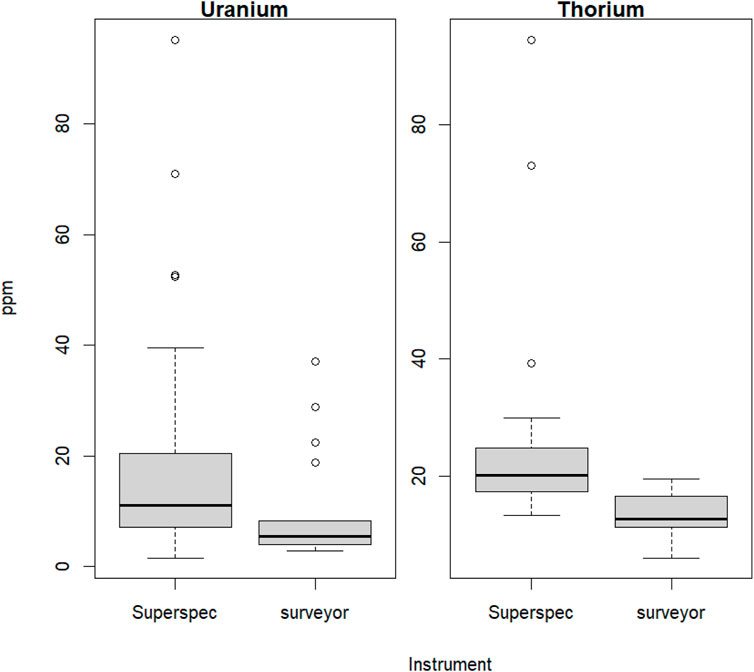
Figure 2. Gamma spectrometer results (ppm) of the two applied instruments: un-collimated Superspec (Radiation Solutions Inc.) vs. lead-collimated gamma surveyor II (GF Instruments).
The dose rate from gamma radiation was measured throughout the study area, using a Colibri dose meter (Canberra), which was carried on person by fastening to the belt during the first field-day in summer 2023, performing measurements every 5 s.
Data handling, figures and Pearson correlation tests were performed using R (R Core Team, 2016).
Results
Alpha track detectors
Compared to the average global outdoor activity concentration of radon and thoron of 10 Bq m-3 (UNSCEAR, 2006), the outdoor levels of radon and thoron measured at Stampa with alpha track detectors were much higher, especially for radon with values up to 2500 Bq m-3 (Table 1, raw data in doi: 10.17632/ybc2ycrpkw.1), but with considerable variation (Figure 3). In the openings of bedrock fractures, levels were much higher with up to 15,000 Bq m-3 (Table 2), but still with considerable variation (Figure 3). The relatively high levels reflect natural outward-directed flow of air from within the fractures during the measurement period. Fracture openings with low levels of radon may be inward ventilating or not ventilating at all. In total, 26 fractures were identified as ventilating with a radon level >1000 Bq m-3, of which eight were during summer months, 19 in March/early April and one in winter. Among the summer-ventilating fractures, three had low radon in winter and early spring while one had high radon also in early spring. The only identified winter ventilating fracture also had high radon in early spring. Across all 34 measurements in the identified ventilating fractures, thoron levels ranged from 180 to 1700 Bq m-3 and the ratio between thoron and radon ranged from 0.09 to 0.35 (mean: 0.18, median:0.17, SD: 0.08). Ventilating fractures with both high radon and thoron could indicate air of recent origin, as thoron has a short half-life (55s). Thus, the alpha track detector results may for the measurement period indicate different ages of air ventilating and hence give an indication about the size and volume of the fracture (system) (Figure 3). Moreover, the levels of radon and thoron in fractures measured with alpha track detectors indicate ventilation was more intense in fracture networks than in single fractures and in the large “cave” fracture (Figure 4). These higher radon levels probably reflect outward-flowing ventilation, while low levels probably indicate no or inward-flowing air. By comparison, the intermediate thoron levels in the “cave” may be due to the dependence of thoron to source and may reflect exhalation from cave walls.

Table 1. Outdoors radon and thoron activity concentrations (Bq m-3) at Stampa measured with alpha track detectors.
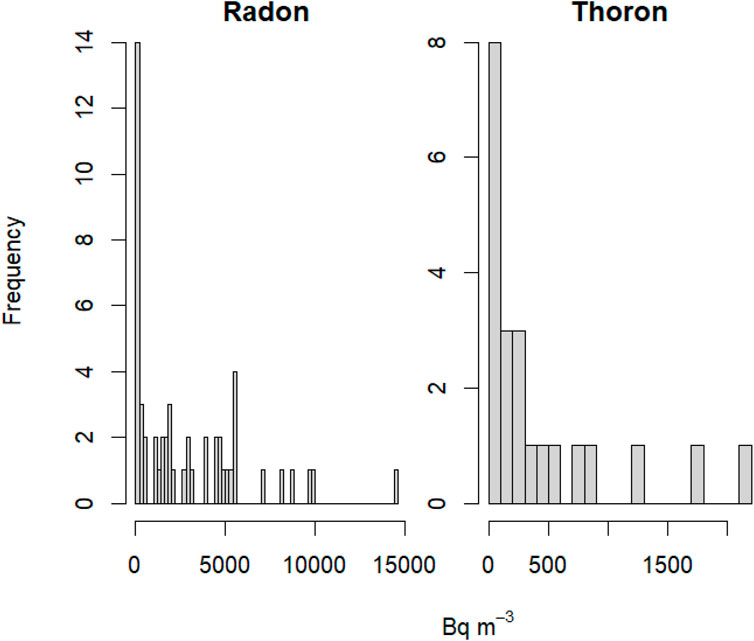
Figure 3. Histograms for radon and thoron alpha track detector measurements from open fractures in the study area at Stampa.

Table 2. Radon and thoron activity concentrations (Bq m-3) in naturally-ventilating fractures at Stampa measured with alpha track detectors.
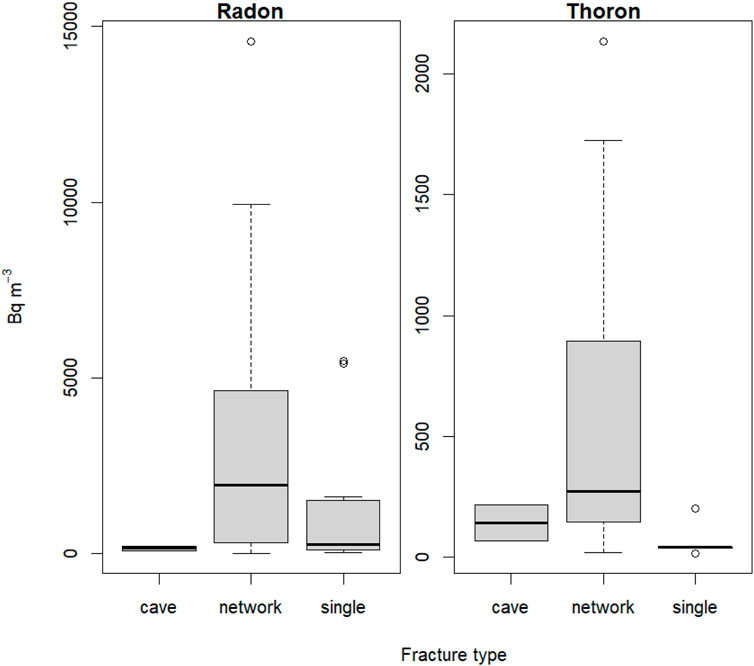
Figure 4. Radon and thoron levels measured with alpha track detectors in different types of fractures at Stampa.
Radon levels in water
Levels of radon in sampled water ranged from 15 to 120 Bq L-1 (mean: 56, median: 56, SD: 38). Groundwater spring samples had 60, 83 and 91 Bq L-1 and stream samples 16 and 17 Bq L-1, which may be expected with turbulence and mixing. For the groundwater spring sample with the highest value, adjacent in-situ measurements of radon showed 1700 and 1200 Bq m-3 while levels decreased to 77 Bq m-3 after some meters’ distance. Alpha track detectors near this groundwater spring locality (1–2 m above ground) showed 590–770 Bq m-3 for radon and 120 and 130 Bq m-3 for thoron. Alpha track detectors at other groundwater springs ranged from 80 to 880 Bq m-3 for radon and from 20 to 260 Bq m-3 for thoron, while at the largest stream, radon was 97 and 120 Bq m-3 and thoron was 16 and 57 Bq m-3. In-situ measurements at one of these groundwater springs showed 150 Bq m-3 of radon. Inside a pump-house, levels from 610 to 1400 Bq m-3 of radon were recorded, but the corresponding water sample only held 43 Bq L-1, signifying that pump-house radon may originate from the ground rather than water. Other tap water samples contained 15, 56, and 120 Bq L-1, which should not pose any issues to indoor levels, since 1000 Bq L-1 in drinking water, as a rule of thumb, yields around 100 Bq m-3 radon indoors (Kulich et al., 1988).
In situ measurments of radon, thoron and progeny in air
In-situ measurements in the warm season among ventilating fractures showed variation in both radon and thoron (Table 3; Figure 5, raw data in doi: 10.17632/ybc2ycrpkw.1). All except one fracture and the cave (ID 20 and 10 in Figure 5, respectively 10) were in the warm season characterised by high radon values measured with alpha track detectors (Figure 1), verifying outward ventilation. Levels of attached progeny ranged up to 10.5 Bq m-3 for radon and 1.6 Bq m-3 for thoron. Applying only attached progeny to calculate the equilibrium factor, the in-situ point measurements involve equilibrium factor (F, the ratio between progeny and progenitor gas) values from 0.001 to 0.004 for radon and from 0.001 to 0.015 for thoron. These are low, probably due to the lacking unattached progeny measurement values and possibly due to loss through deposition onto fracture walls.
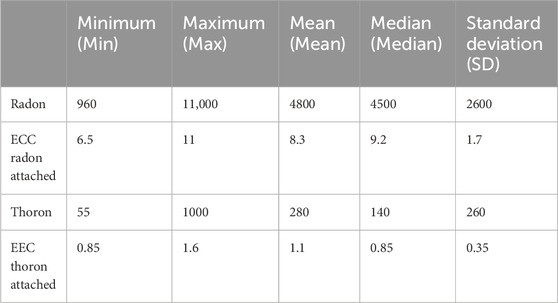
Table 3. Radon, thoron, and their progeny activity concentrations (Bq m-3) in naturally-ventilating fractures at Stampa measured with in-situ instruments.
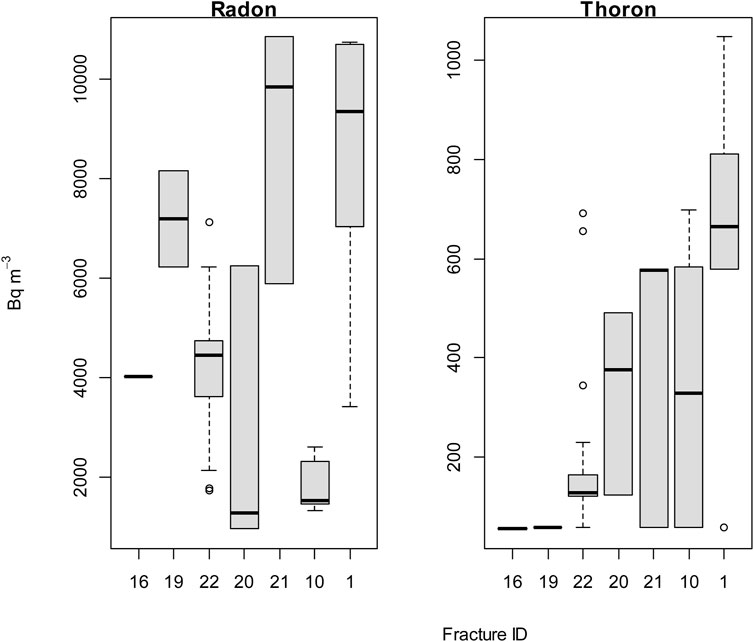
Figure 5. Radon and thoron levels measured in-situ in outward-ventilating fractures (summer/autumn). Note the different scales on the y-axes.
Alpha track detector measurements during the same periods, showed that fracture levels and nearby outdoor locality levels were near significantly correlated for radon (r = 0.66, p > 0.11) but not thoron (r = 0.47, p > 0.34) (Figure 6). This reflects the local impact of fracture ventilation on outdoor levels. Outdoors, the levels of radon, which has the longer half-life (3.5 days), were highest near groundwater springs and running water, demonstrating the importance of water as means of transport and that occupancy at these localities would involve the highest exposure (Figure 7). Especially at a boathouse next to two groundwater springs, the levels were the highest. For thoron, outdoor localities also had the highest levels near groundwater springs and streams, and secondly near fractures and houses.
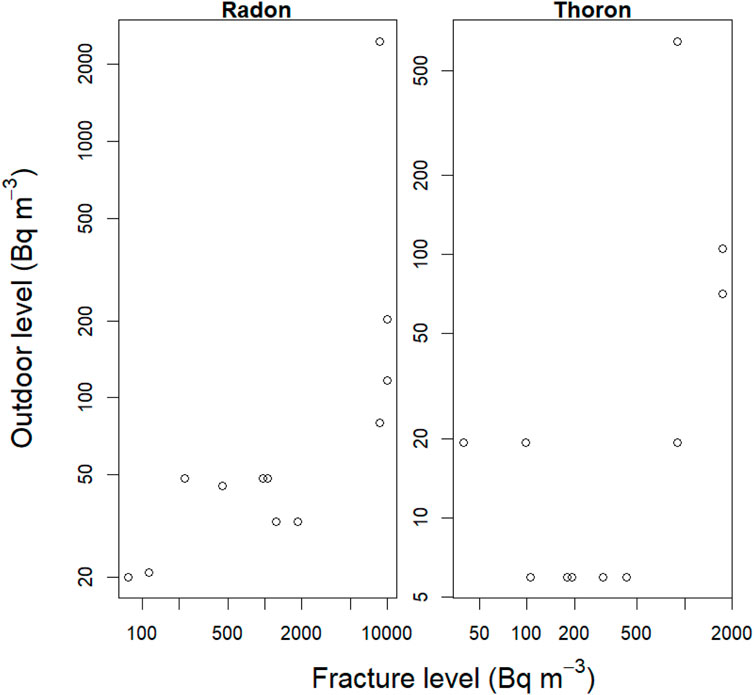
Figure 6. Levels of radon and thoron measured by alpha track detectors in fractures plotted against the levels measured with alpha track detectors nearby (60 m) at outdoor localities (1.5 m above ground).
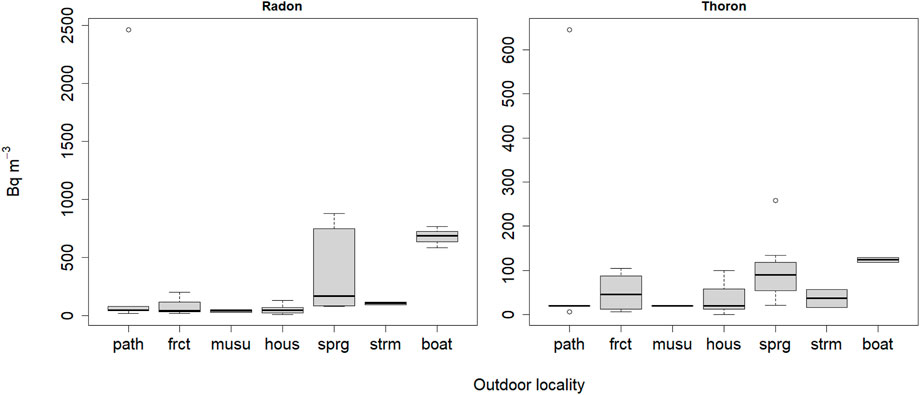
Figure 7. Outdoor levels of radon and thoron measured with alpha track detectors at different types of localities where occupancy is expected in the Stampa area. Locality abbreviations: path (path near fracture), frct (near fracture), musu (museum), hous (at house), park (on parking), sprg (at spring), strm (near stream) and boat (at boathouse near spring).
In-situ warm season outdoor measurements were equally high as the alpha track detector measurements and showed much variation (Table 4). Note the relatively high radon and thoron levels at a parking space, outside resident houses and at the outdoor museum measured with in-situ instruments (Figure 8), which correspond well with the results obtained by the alpha track detectors (Figure 7). The outdoors in-situ measured levels were highest near groundwater springs (including the boathouse location), which could suggest water transport and release, but all these localities are located near sea-level and sinking of cold air down the hillside cannot be excluded. The levels of attached and unattached progeny had a relatively wide range (Table 4). Two relatively high unattached radon progeny fractions were found, one at a fracture and the other at the museum (measurement periods of 60 and 30 min, respectively), which may point to nearby sources, like the groundwater springs. At the museum, the attached and unattached fractions were equal. F values (including attached and unattached) ranged from low to high: 0.03 to 0.65 for radon and 0.01 to 0.13 for thoron.
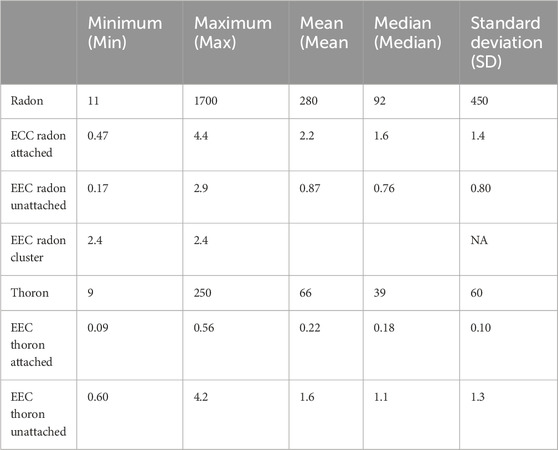
Table 4. Radon, thoron, and their progeny activity concentrations (Bq m-3) outdoors in the Stampa area measured with an in-situ instrument.
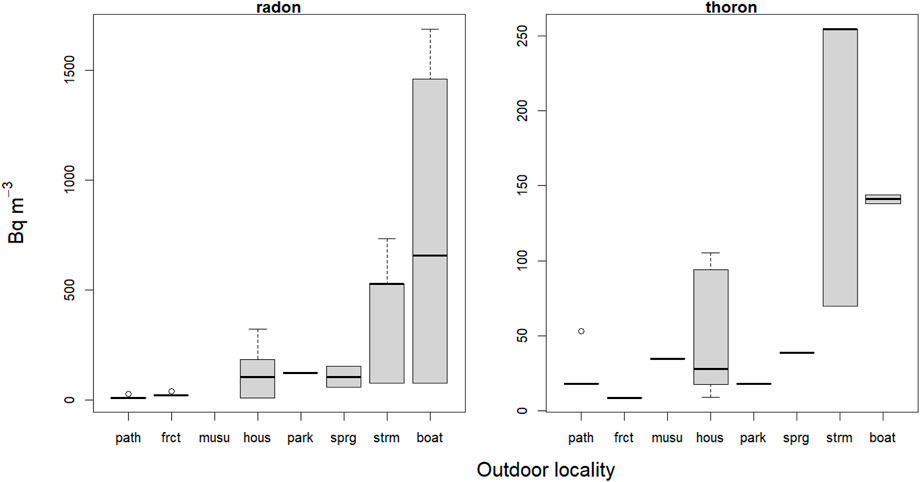
Figure 8. Outdoors radon and thoron levels (1.5 m above ground) at different type of localities at Stampa measured with an in-situ instrument where occupancy is expected in the Stampa area. Locality abbreviations: path (path near fracture), frct (near fracture), musu (museum), hous (at house), park (on parking), sprg (at spring), strm (near stream) and boat (at boathouse near spring). Note the different scales on the y-axes.
Gamma spectrometry measurements
Dose rates measured with the gamma dosimeter at 1 m height on one field-day in 2023 ranged from 0.05 to 0.49 μSv h-1 (mean: 0.2, SD: 0.05). The different lithologies in the area differ in progenitor radionuclides, with graphite layers containing significantly more uranium (Figure 9). These levels of progenitors in the bedrock at fractures were not correlated with fracture levels of radon (r = 0.05, p > 0.85) or thoron (r = -0.2, p > 0.5), nor significantly so with outdoor levels of radon (r = 0.54, p < 0.27) or thoron (r = 0.5, p < 0.34).
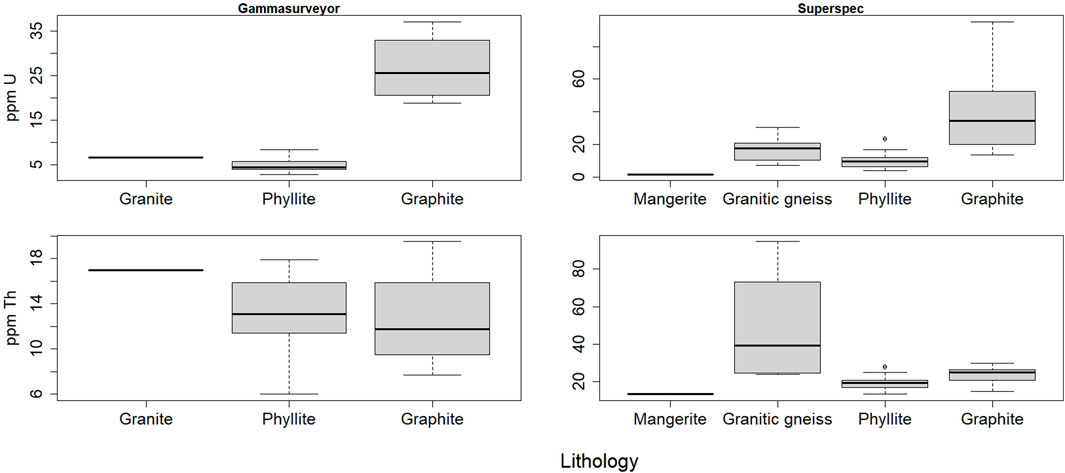
Figure 9. Gamma spectrometric results (parts per million, ppm, y-axis) for uranium (U) and thorium (Th) measured with two instruments in different lithologies (x-axis) in and around Stampa.
Discussion
The main results of this study are the high outdoor levels of radon and thoron compared to the global average of 10 Bq m-3 for radon and thoron (UNSCEAR). We found average outdoor radon values of 230 and 280 Bq m-3 measured with alpha track detectors and in-situ instruments (Tables 1 and 4), respectively, which are higher than the maximum recommended indoor radon level of 200 Bq m-3 in Norway. We identified maximum outdoor values even tenfold higher. The results seem robust since they are given both by integrating alpha track detector measurements through the measurement periods as well as by in-situ point measurements. Our results show that outdoor radon levels in some cases can be high and should not be neglected. We assess several types of outdoor localities in this area, which are regularly frequented like house verandas, hiking trails, a parking lot and a boathouse, making significant exposure likely. For inhabitants of the area who spend a lot of time outdoors, for example, on their veranda in combination with long walks and time at the boathouse, exposure to this outdoor radon may be significant and could be assessed in future studies. However, our study area is not densely populated but represents a popular tourist destination. As such, tourists will only be exposed to these high radon and thoron levels for a short time period. For the few permanent inhabitants and frequent local users of the area, their exposure would have to be assessed in more detail.
To understand the spatial variation in outdoor levels, we identified their most likely sources. For the outdoor localities, the ones with the highest radon levels were the ones adjacent to surfacing groundwater springs, especially at the boathouse, some residential houses and the museum. This may in part be due to downhill transport of water toward the fjord. This seems likely as radon in groundwater from higher elevations may be released at the springs and enhance outdoor levels locally. The levels of radon progeny thus points to a local source. However, the radon levels in water were not so high at these groundwater springs, even though the highest level in spring groundwater was found at the location which also had the highest outdoor levels (the boathouse). The higher outdoor levels at site where groundwater springs surface could be coincidental. The relatively high levels of thoron, which has a short half-life, suggests a short-duration transport. Since movement of water through bedrock or the ground is relatively slow (Henriksen and Dale, 2018), the measured thoron and the progeny of both gases obtained at these localities, points to an alternative source, at least with partial contribution to the outdoor levels. Since these localities with high radon are situated near sea level, one alternative or additional explanation could be that the high outdoor levels here are influenced by cold air that has ventilated from fractures and flows down the hillside and/or cold air from local ventilation systems from within the scree deposits before emerging at sea level. A similar situation from chimney ventilation of cold air moving downhill within rock avalanche deposits has also been shown to have an impact on indoor radon at Kinsarvik, a similar locality in west Norway (Rønning et al., 2023). By comparison, a high local impact on outdoor radon and thoron levels from chimney ventilation was shown for the legacy iron mines at the Fen complex, also during the warm season (Haanes and Rudjord, 2018), showing the potential impact of such downward density flows.
We show that an important source of outdoor radon in this area is the natural ventilation of fractures. That means open fractures can have an enhanced radon and thoron exhalation, particularly when chimney ventilation involves outward-directed airflow through the fractures. Such an outward flux of air with enhanced levels of radon and thoron due to chimney ventilation causes local impacts on outdoor levels. As pointed out above, this has been shown for legacy mines in eastern Norway (Haanes and Rudjord, 2018). Moreover, it is well-known that fissures, faults and open fractures can have a high permeability and can act as pathways for gasses such as radon (O'Connor et al., 1992; Drolet and Martel, 2016). Our results demonstrate enhanced levels in some fracture openings, which suggest, together with an observed outward air flow, natural chimney ventilation from these fractures. The near-significant correlation between fracture radon levels and outdoor radon levels indicates that fracture ventilation impacts outdoor levels. It must however be emphasised that this outward ventilation depends on the season, and for the warm season, the air flowing out of fractures is colder than outside air. Since such cold air is dense, it may stay along the ground during days with little wind, “fill up” topographic depressions and stream down or inside the instability. This process may explain the higher levels at seaside outdoor localities rather than or in addition to releases from groundwater springs, but this should be further assessed in future studies. In the cold seasons, chimney ventilation will be in the opposite direction and air warmer than the outside will ventilate out through higher lying parts of the fractures, before rising into the atmosphere. The one identified winter ventilating fracture was an example of this, as the ventilating fractures identified during early spring. In other regions and areas with open fractures (or rock avalanche deposits, caves or legacy mines), the local impact of natural ventilation on outdoor levels of radon and thoron could therefore be significant and should be assessed, including assessment for seasonality in temperate parts of the world.
For the slope instability, we show that radon and thoron levels differ between single fractures and fracture networks, probably due to a more intense ventilation of fracture networks. We expect that in single open fractures, outside air may enter at one elevation and exit at another. In comparison, open fracture networks may have multiple possible entry points, a larger surface area for exhalation of radon and thoron, a larger volume, and chimney ventilation patterns may be more intense. Among the fractures, low radon values but intermediate thoron values probably result from short travelling times. In ventilating fractures with more thoron, the source must be closer, and air is therefore younger, probably due to shorter fractures, smaller fracture volumes, much higher speeds of ventilation or a combination. By comparison, high radon levels but little thoron may signify a longer travelling time and a larger fracture system. Assessing such ventilation systems, radon and thoron measurements can therefore, together with measurements of temperature and airflow, be used. A question that still remains is to what extent fractures have separate natural chimney ventilation and to what degree such ventilation may extend below parts or the whole unstable rock slope from seaside to almost 1000 m above sea.
The lack of significant correlation between bedrock progenitors on one hand, and radon and thoron levels in fractures or outdoors on the other hand is not so surprising given the self-shielding effect of bedrock and probably natural variation within one and the same lithology. Measurements made at some points on the surface are probably not representative of levels in fracture surface nor the bedrock surface from where exhalation occurs. The question of whether bedrock progenitor levels within fractures may help explain fracture and outdoor levels of radon and thoron could thus not be answered. Generally low levels in the ground are supported by the hand-held gamma dosimeter results, which are mostly low. However, given the relatively high radon levels in some ventilating fractures, graphite layers are probably exposed at surfaces in these fractures, possibly occurring as spots of elevated activity.
Further studies could also address plausible doses from the enhanced outdoor levels at Stampa, possibly also including indoor doses. Future work should also assess temporal variation of ventilation direction and flux in the Stampa fractures and map the extent of the fracture networks, possibly comparing with co-variation in weather parameters.
Conclusion
Outdoors levels of thoron and especially radon, are high in the unstable rock slope Stampa due to the occurrence of natural ventilation from open fracture networks. Radon and thoron concentrations in fracture openings depend on the direction of air flow, being high during outward flow. Flow rate, fracture volume and length probably have an effect as well. This is supported by the higher radon and thoron levels in air from fracture network systems compared to single fractures. Significant outdoor exposure levels are found at localities used for occupancy by both locals and tourists including verandas, parking spaces, trails and especially a boathouse. Especially near surfacing groundwater springs, outdoor levels are high, possibly due to transport by and release from spring groundwater.
Data availability statement
Raw data are available at Mendeley data repository (doi:10.17632/ybc2ycrpkw.1).
Author contributions
HH: Funding acquisition, Resources, Writing – original draft, Investigation, Formal Analysis, Visualization, Conceptualization, Project administration, Data curation, Validation, Writing – review and editing, Methodology. PS: Resources, Formal Analysis, Writing – original draft, Investigation, Data curation, Methodology, Conceptualization, Writing – review and editing. AM: Writing – review and editing, Writing – original draft, Resources, Data curation. TS: Writing – original draft, Methodology, Funding acquisition, Formal Analysis, Investigation, Conceptualization, Data curation, Resources, Writing – review and editing, Project administration.
Funding
The author(s) declare that financial support was received for the research and/or publication of this article. This research was part of the RadoNorm project. It has received funding from Research Council of Norway (EU-STRA) due to participation in the Euratom research and training programme 2019–2020 under grant agreement No 900009.
Acknowledgments
We thank Vikas Chand Baranwal from the Geological Survey of Norway for providing the gamma spectrometer. Lukas Schild and Sigurd Daniel Nerhus from Western Norway University of Applied Sciences (campus Sogndal) is thanked for assistance in the field. For honest comments to our manuscript we thank Ralf Ehrlich, DSA. We also thank our laboratory staff for providing equipment for and analyses of radon in water. We thank Warren John (Bfs/Radonorm project) for the proofreading of a native Englishman.
Conflict of interest
The authors declare that the research was conducted in the absence of any commercial or financial relationships that could be construed as a potential conflict of interest.
Generative AI statement
The author(s) declare that no Generative AI was used in the creation of this manuscript.
Publisher’s note
All claims expressed in this article are solely those of the authors and do not necessarily represent those of their affiliated organizations, or those of the publisher, the editors and the reviewers. Any product that may be evaluated in this article, or claim that may be made by its manufacturer, is not guaranteed or endorsed by the publisher.
References
Ayo-Bali, A., and Ajayi, K. M. (2024). Characterization of rock fractures for fractal modeling of radon gas transport. J. Environ. Radioact. 280, 107543. doi:10.1016/j.jenvrad.2024.107543
BEIR-VI (1999). “Health effects of exposure to radon,” in BEIR-VI report. Committee on health risks of exposure to radon. Washington DC: National Research Council.
Böhme, M., Dehls, J., Hermanns, R. L., Oppikofer, T., Redfield, T., Rønning, J. S., et al. (2013). “The unstable phyllitic rocks in stampa – flåm, Western Norway: compilation, scenarios, risk and recommendations,”. Oslo, Norway.Nor. Water Resour. Energy Dir. (NVE). Available online at: https://publikasjoner.nve.no/rapport/2013/rapport2013_35.pdf
Çevik, U., Kara, A., Çelik, N., Karabidak, S. M., and Çelik, A. (2012). Radon survey and exposure assessment in karaca and Çal caves, Turkey. Water Air Soil Pollut. 214, 461–469. doi:10.1007/s11270-010-0437-6
Corfu, F. (2023). The jotun–valdres nappe complex: a synthesis and new U–Pb ages. Nor. J. Geol. 103 (3). doi:10.17850/njg103-3-3
Darby, S., Hill, D., Deo, H., Auvinen, A., Barros-Dios, J. M., Baysson, H., et al. (2006). Residential radon and lung cancer--detailed results of a collaborative analysis of individual data on 7148 persons with lung cancer and 14,208 persons without lung cancer from 13 epidemiologic studies in Europe. Scand. J. work, Environ. & health 32 (Suppl. 1), 1–83. Available online at: https://www.sjweh.fi/download.php?abstract_id=982&file_nro=2
Drolet, J.-P., and Martel, R. (2016). Distance to faults as a proxy for radon gas concentration in dwellings. J. Environ. Radioact. 152, 8–15. doi:10.1016/j.jenvrad.2015.10.023
Haanes, H., Dahlgren, S., and Rudjord, A. L. (2023). Cold season dose rate contributions from Gamma, radon, thoron or progeny in legacy mines with high natural background radiation. Radiat. Prot. Dosim. 199 (12), 1284–1294. doi:10.1093/rpd/ncad178
Haanes, H., and Rudjord, A. L. (2018). Significance of seasonal outdoor releases of thoron from airflow through a point source during natural ventilation of a mine-complex in thorium-rich bedrock. Atmos. Pollut. Res. 9 (6), 1000–1008. doi:10.1016/j.apr.2018.03.007
Henriksen, H., and Dale, T. (2018). Groundwater discharge from a rock-slope failure system in phyllitic rocks influencing fjord basin hydrodynamics, stampa in aurland, Western Norway. Nor. J. Geol. 98. doi:10.17850/njg98-1-05
Jerstad, A., Jensen, C. L., Ramberg, G. B., Ruden, L., Ånestad, K., and Strand, T. (2003). Kartlegging av radon i aurland kommune. Statens Strålevern, Østerås, Nor. (In Norwegian). Available online at: https://www.dsa.no/publikasjoner/stralevernrapport-9-2003-kartlegging-av-radon-i-44-kommuner-2003/straalevernrapport-2003-9-kartlegging-radon-kommuner-2003.pdf
Johnová, K., Thinová, L., and Giammanco, S. (2014). Revealing the hidden faults in the SE flank of mt. Etna using radon in-soil gas measurement. Radiat. Prot. Dosim. 160 (1-3), 70–73. doi:10.1093/rpd/ncu092
Kulich, J., Möre, H., and Swedjemark, G. A. (1988). Radon and radium in Swedish drinking water (in Swedish). Norges Geol. Unders. (NGU) 380, 125–142. Available online at: https://inis.iaea.org/records/p48pd-wt055
Monnin, M. M., and Seidel, J. L. (1997). Physical models related to radon emission in connection with dynamic manifestations in the upper terrestrial crust: a review. Radiat. Meas. 28 (1), 703–712. doi:10.1016/S1350-4487(97)00168-6
Neri, M., Giammanco, S., Ferrera, E., Patanè, G., and Zanon, V. (2011). Spatial distribution of soil radon as a tool to recognize active faulting on an active volcano: the example of mt. Etna (italy). J. Environ. Radioact. 102 (9), 863–870. doi:10.1016/j.jenvrad.2011.05.002
O'Connor, P. J., Gallagher, V., Van den Boom, G., Hagendorf, J., Müller, R., Madden, J. S., et al. (1992). Mapping of 222Rn and 4He in soil gas over a karstic limestone-granite boundary: correlation of high indoor 222Rn with zones of enhanced permeability. Radiat. Prot. Dosim. 45 (1-4), 215–218. doi:10.1093/rpd/45.1-4.215
Ogden, T. L. (2010). Handling results below the level of detection. Ann. Occup. Hyg. 54 (3), 255–256. doi:10.1093/annhyg/mep099
Petermann, E., and Hoffmann, B. (2025). Mapping the exposure to outdoor radon in the German population. J. Environ. Radioact. 281, 107583. doi:10.1016/j.jenvrad.2024.107583
R Core Team (2016). “R: a language and environment for statistical computing,” in Computing RFfS (Vienna, Austria). Available online at: https://www.R-project.org/.
Rønning, J. S., Böhme, M., Fredin, O., Hansen, L., Hermanns, R. L., Ofstad, F., et al. (2023). Rock-avalanche deposit causes extreme high indoor radon concentrations in kinsarvik, ullensvang municipality, Western Norway. Eng. Geol. 321, 107136. doi:10.1016/j.enggeo.2023.107136
Solomon, S. B., Cooper, M. B., O'Brien, R. S., and Wilkinson, L. (1992). Radon exposure in a limestone cave. Radiat. Prot. Dosim. 45 (1-4), 171–174. doi:10.1093/rpd/45.1-4.171
Sundal, A. V., Valen, V., Soldal, O., and Strand, T. (2008). The influence of meteorological parameters on soil radon levels in permeable glacial sediments. Sci. total Environ. 389 (2-3), 418–428. doi:10.1016/j.scitotenv.2007.09.001
UNSCEAR (2006). “Effects of ionizing radiation. Volume II, annex E: sources-To-Effects assessment for radon in homes and workplaces,” in UNSCEAR report to the general assembly, with annexes. United Nations Scientific Committee on the Effect of Atomic Radiation NY.
Wang, Y., Luo, W., Zeng, G., Wang, Y., Yang, H., Wang, M., et al. (2019). High 222Rn concentrations and dynamics in shawan cave, southwest China. J. Environ. Radioact. 199-200, 16–24. doi:10.1016/j.jenvrad.2018.12.029
Yakut, H., Tabar, E., Yıldırım, E., Zenginerler, Z., Ertugral, F., and Demirci, N. (2017). SOIL GAS RADON MEASUREMENT AROUND FAULT LINES ON THE WESTERN SECTION OF THE NORTH ANATOLIAN FAULT ZONE IN TURKEY. Radiat. Prot. Dosim. 173 (4), ncw009–ncw413. doi:10.1093/rpd/ncw009
Keywords: radon, thoron, ventilation, bedrock fracture, phyllite, exhalation, outdoor levels
Citation: Haanes H, Snook P, Maschler A and Scheiber T (2025) Outdoor radon and thoron in an area with naturally ventilating bedrock fractures. Front. Environ. Sci. 13:1599780. doi: 10.3389/fenvs.2025.1599780
Received: 03 April 2025; Accepted: 13 June 2025;
Published: 02 July 2025.
Edited by:
Christian Di Carlo, National Institute of Health (ISS), ItalyReviewed by:
Chutima Kranrod, Hirosaki University, JapanYongjun Ye, University of South China, China
Biljana Vuckovic, University of Pristina, Serbia
Katerina Navratilova Rovenska, National Radiation Protection Institute (NRPI), Czechia
Copyright © 2025 Haanes, Snook, Maschler and Scheiber. This is an open-access article distributed under the terms of the Creative Commons Attribution License (CC BY). The use, distribution or reproduction in other forums is permitted, provided the original author(s) and the copyright owner(s) are credited and that the original publication in this journal is cited, in accordance with accepted academic practice. No use, distribution or reproduction is permitted which does not comply with these terms.
*Correspondence: Hallvard Haanes, aGFsbHZhcmQuaGFhbmVzQGRzYS5ubw==
 Hallvard Haanes
Hallvard Haanes Paula Snook
Paula Snook Alexander Maschler
Alexander Maschler Thomas Scheiber2
Thomas Scheiber2